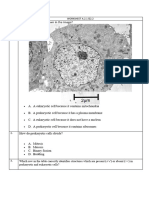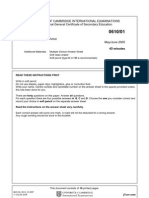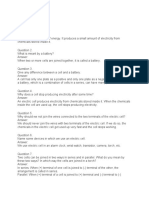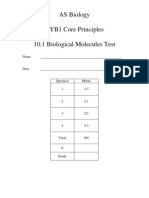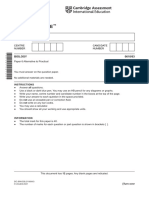Homework 1.1: A: Cell Structure and B: Viruses
Homework 1.1: A: Cell Structure and B: Viruses
Uploaded by
MikeCopyright:
Available Formats
Homework 1.1: A: Cell Structure and B: Viruses
Homework 1.1: A: Cell Structure and B: Viruses
Uploaded by
MikeOriginal Title
Copyright
Available Formats
Share this document
Did you find this document useful?
Is this content inappropriate?
Copyright:
Available Formats
Homework 1.1: A: Cell Structure and B: Viruses
Homework 1.1: A: Cell Structure and B: Viruses
Uploaded by
MikeCopyright:
Available Formats
Homework 1.
1
A: Cell structure and B: Viruses
In question 1, you will check your understanding of some important terminology, and practise carrying
out magnification calculations that involve converting units between mm and µm.
Question 2 refers to the structure and classification of viruses and will help you to identify differences
between the structure of a virus and a prokaryotic cell.
1 a Explain what is meant by the terms magnification and resolution. [2]
b Explain why the details of the structure of a chloroplast can be seen using an electron
microscope, but not with a light microscope. [3]
c The photograph below shows two plant cells, as seen using a light microscope.
i Measure the maximum length of the cell labelled P. [1]
ii The actual length of this cell is 200 m. Using your measurement, calculate the
magnification of this photograph. [2]
iii These plant cells contain chloroplasts and mitochondria.
Give two similarities between the structure of a chloroplast and the structure of a
mitochondrion. [2]
d Chloroplasts and mitochondria both produce ATP.
Give two roles of ATP in plant cells. [2]
[Total: 12]
2 a Outline two ways in which the structure of a virus differs from the structure of a typical
prokaryotic cell. [2]
b Describe how viruses are classified, with reference to nucleic acids. [2]
[Total: 4]
Cambridge International AS and A Level Biology © Cambridge University Press 2014 1
You might also like
- Activity 19.1 Marking Scheme: Investigating The Primary Structure of RibonucleaseDocument3 pagesActivity 19.1 Marking Scheme: Investigating The Primary Structure of RibonucleaseMikeNo ratings yet
- Paper 2-Magnification Study QuestionsDocument14 pagesPaper 2-Magnification Study QuestionsMartin Duarte Jaramillo100% (1)
- Worksheet Ib HL - Chapter A2.1& 2.2Document12 pagesWorksheet Ib HL - Chapter A2.1& 2.2elizabethNo ratings yet
- Booklet 2 Topic 1Document61 pagesBooklet 2 Topic 1Sarah Al ObaidanNo ratings yet
- 5.1 Exothermic and Endothermic Reactions MCQ QPDocument10 pages5.1 Exothermic and Endothermic Reactions MCQ QPRehman MunirNo ratings yet
- Unit 4 .4.1ecosystem - Week 1Document19 pagesUnit 4 .4.1ecosystem - Week 1Taima ZiadNo ratings yet
- 0610 s05 QP 1Document16 pages0610 s05 QP 1Hubbak Khan100% (1)
- ScienceDocument15 pagesSciencechantel.markin100% (1)
- AE.23072022.Potential Difference, Resistance and Current AnswersDocument2 pagesAE.23072022.Potential Difference, Resistance and Current AnswersĐặng Thái Nhật100% (1)
- Chemistry IGCSE I End of Chapter 1 TESTDocument3 pagesChemistry IGCSE I End of Chapter 1 TESTmfjguambeNo ratings yet
- Year 9 Chemistry First Term Revision Worksheet 2023-24: (A) The Diagram Shows A Heating Curve For A Sample of Compound XDocument11 pagesYear 9 Chemistry First Term Revision Worksheet 2023-24: (A) The Diagram Shows A Heating Curve For A Sample of Compound XSara RashmiNo ratings yet
- Chapter 8Document14 pagesChapter 8wallacec1017100% (1)
- Transfer of Thermal Energy - Conduction - Convection - Radiation - Applications of Thermal Energy TransferDocument49 pagesTransfer of Thermal Energy - Conduction - Convection - Radiation - Applications of Thermal Energy TransferImmanuel Suman ShijuNo ratings yet
- Cambridge Science Year 7 LB Lyp Part 2Document24 pagesCambridge Science Year 7 LB Lyp Part 2aalqadasi7No ratings yet
- Electricity and Circuits Related Questions (CH 12)Document50 pagesElectricity and Circuits Related Questions (CH 12)Srijan MauryaNo ratings yet
- Year 7 Gas Pressure WorksheetDocument3 pagesYear 7 Gas Pressure Worksheeteng.reham.maher.mNo ratings yet
- Cambridge Lower Secondary Progression Test Paper 1 Answers (My Own Answers)Document20 pagesCambridge Lower Secondary Progression Test Paper 1 Answers (My Own Answers)bingxun.chua6No ratings yet
- Unit 1 Waves RevisionDocument2 pagesUnit 1 Waves RevisionLix FNNo ratings yet
- 0654/33/M/J/22 © Ucles 2022Document30 pages0654/33/M/J/22 © Ucles 2022LongNo ratings yet
- IGCSE 1 Biology Test 1Document9 pagesIGCSE 1 Biology Test 1harsh ghagNo ratings yet
- Physics Test Grade9!1!2023Document10 pagesPhysics Test Grade9!1!2023Mahmod YaishNo ratings yet
- Comprehension - Crabby & It Was Long AgoDocument5 pagesComprehension - Crabby & It Was Long AgoIshika MoroliaNo ratings yet
- Membrane Transport Practice QuestionsDocument2 pagesMembrane Transport Practice QuestionsLogan ParkisonNo ratings yet
- 1.1 The Human Respiratory System - 1.2 Gas Exchange - 1.3 BreathingDocument26 pages1.1 The Human Respiratory System - 1.2 Gas Exchange - 1.3 BreathingAla' ShehadehNo ratings yet
- Science Part 3 PDF Solubility WatereDocument1 pageScience Part 3 PDF Solubility Wateresohambhole2011100% (1)
- IGCSE Physics Screening Test 1Document19 pagesIGCSE Physics Screening Test 1antonylukNo ratings yet
- 8 Science Worksheet ch2 1Document3 pages8 Science Worksheet ch2 1KSP Classes GondiaNo ratings yet
- Year 7 CWDocument6 pagesYear 7 CWKissiedu YirenkyiNo ratings yet
- Cambridge IGCSE: Biology 0610/11Document20 pagesCambridge IGCSE: Biology 0610/11Tamer Ahmed100% (1)
- Animal and Plant Cells AssessmentDocument2 pagesAnimal and Plant Cells AssessmentMariMarNo ratings yet
- Plant Structure AnswersDocument2 pagesPlant Structure AnswersAnonymous Gesp0OErNo ratings yet
- GRADE 7 Act. 2Document4 pagesGRADE 7 Act. 2Ferdinand Abalos NamquiNo ratings yet
- HW 3Document38 pagesHW 3Khalid WaleedNo ratings yet
- AS Biology BYB1 Core Principles 10.1 Biological Molecules TestDocument5 pagesAS Biology BYB1 Core Principles 10.1 Biological Molecules TestAusten James HeeleyNo ratings yet
- Y8 Worksheet On Respiration and Gas ExchangeDocument4 pagesY8 Worksheet On Respiration and Gas Exchangetayyabfaiz292No ratings yet
- Science 7 2nd Trime Exam (Editable PDFDocument5 pagesScience 7 2nd Trime Exam (Editable PDFFrederick EspejoNo ratings yet
- Year 8 PTM Worksheet-2Document6 pagesYear 8 PTM Worksheet-2Rushabh BhosaleNo ratings yet
- 2023 Energy and Heat Practice Tests AnswersDocument10 pages2023 Energy and Heat Practice Tests Answers27johliNo ratings yet
- Grade 9 Thermal Energy TransferDocument2 pagesGrade 9 Thermal Energy TransferR4iD100% (1)
- My TestDocument20 pagesMy TestHidayah Teacher100% (1)
- Year 8Document8 pagesYear 8MR AnonymousNo ratings yet
- Year 9 Chemistry Midterm ExamsDocument7 pagesYear 9 Chemistry Midterm Examss.ratemoNo ratings yet
- Cambridge IGCSE: CHEMISTRY 0620/42Document16 pagesCambridge IGCSE: CHEMISTRY 0620/42Kohinoor BegumNo ratings yet
- G6 Ecology Progress TestDocument9 pagesG6 Ecology Progress TestpixelhoboNo ratings yet
- Stage 9 Chemistry Pe1Document8 pagesStage 9 Chemistry Pe1sneakyNo ratings yet
- Exe 19.7 - Structure (Food Web)Document7 pagesExe 19.7 - Structure (Food Web)Hanie100% (2)
- Unit 6 Revision Worksheet - Answer KeyDocument11 pagesUnit 6 Revision Worksheet - Answer Keyhung.nguyenquoc89No ratings yet
- 17.2 Inheritance Igcse Cie Biology Ext Theory QPDocument11 pages17.2 Inheritance Igcse Cie Biology Ext Theory QPivannn510510No ratings yet
- English Y7-The Homeschooling DebateDocument7 pagesEnglish Y7-The Homeschooling DebateGeeta AswaniNo ratings yet
- Cambridge IGCSE: BIOLOGY 0610/63Document12 pagesCambridge IGCSE: BIOLOGY 0610/63bali yunNo ratings yet
- Homeworks 1 eDocument8 pagesHomeworks 1 eSumi VjNo ratings yet
- Bonding and Lewis Structures WorksheetDocument2 pagesBonding and Lewis Structures WorksheetLarry MolinerosNo ratings yet
- 13 Science 2011Document22 pages13 Science 2011madhujayan0% (1)
- APznzaYmSLD5xtQQwd7h0CcmEjkaC1n yfqyuwDfFmsV7Cupc1Oz27UTFiNps8mMlKVxW48ndYZTnSGD9Lnl7DkdslrvxCG6gc0GOYZ2G7-FXwvvZeERZvmg9urNqkJrKxbW7vJCBIJpWzvW2qF6iv IdcNcLMuxaEpx2MQWW6eb9g7f-7TauIrVteRmpbZyFzoxVDocument5 pagesAPznzaYmSLD5xtQQwd7h0CcmEjkaC1n yfqyuwDfFmsV7Cupc1Oz27UTFiNps8mMlKVxW48ndYZTnSGD9Lnl7DkdslrvxCG6gc0GOYZ2G7-FXwvvZeERZvmg9urNqkJrKxbW7vJCBIJpWzvW2qF6iv IdcNcLMuxaEpx2MQWW6eb9g7f-7TauIrVteRmpbZyFzoxVdefinitelynotjamie1No ratings yet
- CH 13 EXCRETION IN HUMANS - QuestionsDocument10 pagesCH 13 EXCRETION IN HUMANS - QuestionsPranitha RaviNo ratings yet
- Year 7 Biology Unit4Document10 pagesYear 7 Biology Unit4mado6920111No ratings yet
- Biology Worksheet IgcseDocument10 pagesBiology Worksheet Igcsenethramahendiran4No ratings yet
- Year 9 Carbon Cycle Igcse Exam QuestionsDocument8 pagesYear 9 Carbon Cycle Igcse Exam Questionslauraalawadi67No ratings yet
- Mid Term 1stbioDocument2 pagesMid Term 1stbioDewjan KadupitiyaNo ratings yet
- 9700 - Y19-21 - Sy As Level Biology SyllabusDocument17 pages9700 - Y19-21 - Sy As Level Biology SyllabusWiji NingNo ratings yet
- 2.1 Cell Structure QPDocument22 pages2.1 Cell Structure QPFatima NissaNo ratings yet
- Ch01 TGDocument9 pagesCh01 TGMikeNo ratings yet
- SynapseDocument19 pagesSynapseMikeNo ratings yet
- Worksheet C1.06: Catalysts in CarsDocument2 pagesWorksheet C1.06: Catalysts in CarsMikeNo ratings yet
- SAPS - Microscale Investigations With Catalase - Technical SheetDocument4 pagesSAPS - Microscale Investigations With Catalase - Technical SheetMikeNo ratings yet
- Worksheet C9.04: The Industrial Electrolysis of BrineDocument1 pageWorksheet C9.04: The Industrial Electrolysis of BrineMikeNo ratings yet
- Worksheet C1.01: What Use Is Chemistry?Document2 pagesWorksheet C1.01: What Use Is Chemistry?MikeNo ratings yet
- Worksheet C1.03: What Happened To All The Carbon Dioxide?Document3 pagesWorksheet C1.03: What Happened To All The Carbon Dioxide?MikeNo ratings yet
- Worksheet C11.03: Addition Polymers and Their UsesDocument2 pagesWorksheet C11.03: Addition Polymers and Their UsesMikeNo ratings yet
- Practical 18.5: Observing Single-Celled OrganismsDocument2 pagesPractical 18.5: Observing Single-Celled OrganismsMikeNo ratings yet
- Practical 1.2: Preparing A Slide of Human Cheek CellsDocument2 pagesPractical 1.2: Preparing A Slide of Human Cheek CellsMikeNo ratings yet
- Practical 1.3: Preparing A Slide of Elodea Leaf CellsDocument2 pagesPractical 1.3: Preparing A Slide of Elodea Leaf CellsMikeNo ratings yet
- Homework 18.1: Biodiversity, Classification and ConservationDocument2 pagesHomework 18.1: Biodiversity, Classification and ConservationMikeNo ratings yet


